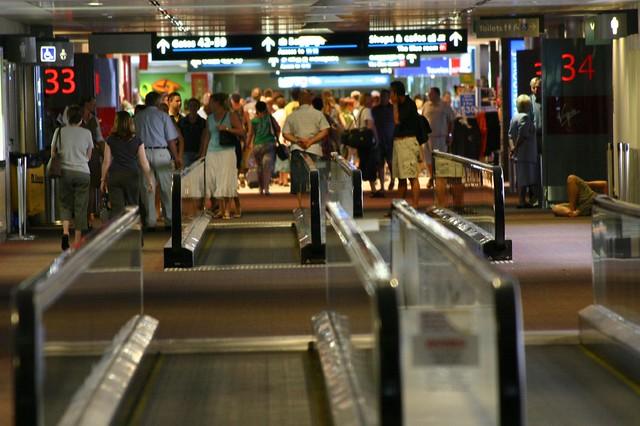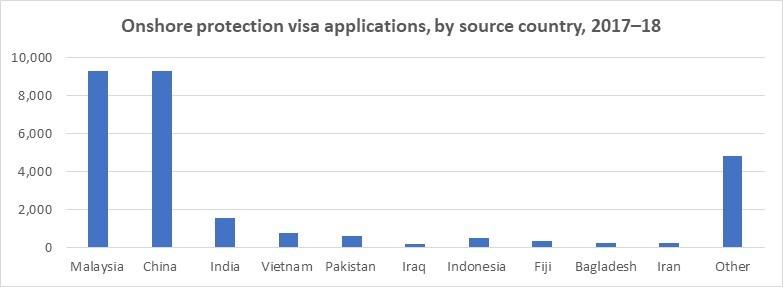Organised crime is testing Australia’s onshore migration program
Posted By John Coyne on August 29, 2019 @ 11:57

Since its inception in 2013, Operation Sovereign Borders [1] has reduced the number of irregular migrants dying at sea and stemmed the flow of people-smuggling ventures to Australia. Unfortunately, this success has come at great cost to our nation’s finances, and possibly our humanity.
With Australia’s maritime borders secured, at least for the moment, our attention needs to turn towards strengthening our onshore humanitarian program against exploitation and reprioritising our temporary visa classes.
In 2016–17 [2], 18,290 applications for protection visas were lodged; in 2017–18, the number jumped to 27,931. As the number of claims rises, the Australian Border Force and the Department of Home Affairs are spending an increasing amount of time and resources on processing applications lodged onshore, more than 80% of which are rejected.
Home Affairs’ 2017–18 annual report [3] states that 99% of the 8,694,048 people granted temporary visas in that year maintained their lawful immigration status while in Australia. However, an estimated 86,940 people who entered Australia in 2017–18 breached their visa conditions. Many of them quickly left the country, but as of 30 June 2017, there were 62,900 unlawful non-citizens residing in Australia—a number that has remained roughly constant over the past few years.
As former immigration minister Philip Ruddock has said repeatedly [4], ‘a cohesive, resilient, multicultural Australia can be generous within our capacity to help those in greatest need’. But he has also acknowledged that this approach relies on strong border security.
Maintaining strong border security is becoming increasingly challenging in a world where the demand for protection and economic opportunity far outweighs the available supply.
The security conditions in Syria, Afghanistan, Central America, North Korea, Iraq and Iran continue to contribute to the globe’s unprecedented mass migration crises. However, most of the air arrival and onshore protection applications in Australia do not originate from those countries.

Unfortunately, the refugee and migration programs in destination countries can’t accommodate the level of demand from those who want to migrate to them. The demand for alternative migration pathways has grown, and it’s a demand that organised crime groups have been quick to exploit.
Limited economic opportunities resulting from factors such as ballooning youth populations, widespread corruption and surpluses of unskilled labour are creating waves of irregular economic migrants who, under normal circumstances, have no likelihood of being accepted into formal migration programs.
Australia’s onshore humanitarian program is composed of irregular maritime and air arrivals. While the boats have been stopped, the number of people travelling to Australia by air on student or tourist visas, for example, and claiming asylum on arrival has increased significantly over the past two years.
It’s not a crime, nor is it necessarily a national security risk, for someone to claim asylum or seek protection. But it’s critical to note that many of the people who abuse the temporary visa system are complicit in criminal activity in that they knowingly engage the services of criminal groups to obtain visas to which they would not be otherwise entitled.
Some air arrivals experience exploitation in some circumstances, including indentured labour arrangements. However, such conditions often don’t meet the threshold for human trafficking and modern slavery under Australian law.
Organised crime syndicates are facilitating unlawful migration on a fee-for-service basis, using methods such as fake identity documents to game Australia’s visa system. Australia’s border security arrangements are being subverted and individuals who have not been appropriately identified are at times entering the country.
Australia is facing very real challenges in resolving the issue of onshore protection claims and temporary visa non-compliance.
The demand for immigration detention and deportation, and their associated costs, exceed the current resourcing of the Department of Home Affairs and the Border Force. This is reflected in the growing number of bridging visas being granted. And administratively, managing cases is a long and expensive process.
Often, the Australian Border Force lacks the necessary legislative powers under the Migration Act to address serious and organised criminal activity. And while the Australian Federal Police has the legislative powers, it lacks the resources.
It’s easy to see why Home Affairs has used extraterritorial methods to assist Australia’s migration controls, including implementing strict visa requirements, imposing sanctions on carriers that bring incorrectly documented arrivals, deploying airline liaison officers, and using biometric technologies and the occasional excising of territory for the purposes of the Migration Act.
These measures are critical to reducing the number of onshore visa applications that are later denied, and the potential exploitation of other temporary visa classes.
In developing new responses, it’s important to resist the temptation to make small policy tweaks, especially with respect to risk-based decision-making.
While short-term measures might yield some initial successes, what’s needed is a long-term investment in integrating Home Affairs’ information systems, including those that process Australian visas. Attention also needs to be focused on developing the risk-modelling and big-data-analytics capabilities that inform visa and border decision-making.
Given the scale of the issue, there’s also a clear need for the Joint Standing Committee on Migration to conduct an inquiry into how current operational activity is disrupting irregular migrant channels in the air stream.
Article printed from The Strategist: https://aspistrategist.ru
URL to article: /organised-crime-is-testing-australias-onshore-migration-program/
URLs in this post:
[1] Operation Sovereign Borders: https://osb.homeaffairs.gov.au
[2] 2016–17: https://www.homeaffairs.gov.au/research-and-stats/files/ohp-june-18.pdf
[3] annual report: https://www.homeaffairs.gov.au/reports-and-pubs/Annualreports/2017-18/01-annual-report-2017-18.pdf
[4] said repeatedly: https://www.aspistrategist.ru/report/people-smugglers-globally-2017
Click here to print.